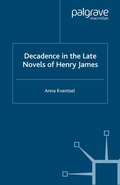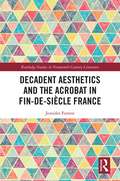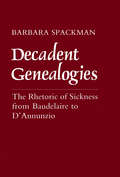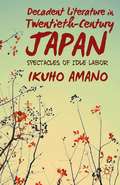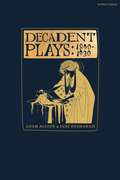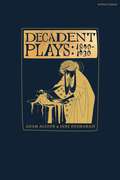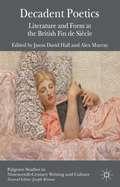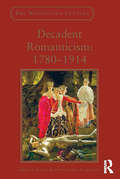- Table View
- List View
Decadence in the Age of Modernism (Hopkins Studies in Modernism)
by Kate Hext Alex MurrayDecadence in the Age of Modernism begins where the history of the decadent movement all too often ends: in 1895. It argues that the decadent principles and aesthetics of Oscar Wilde, Walter Pater, Algernon Swinburne, and others continued to exert a compelling legacy on the next generation of writers, from high modernists and late decadents to writers of the Harlem Renaissance. Writers associated with this decadent counterculture were consciously celebrated but more often blushingly denied, even as they exerted a compelling influence on the early twentieth century. Offering a multifaceted critical revision of how modernism evolved out of, and coexisted with, the decadent movement, the essays in this collection reveal how decadent principles infused twentieth-century prose, poetry, drama, and newspapers. In particular, this book demonstrates the potent impact of decadence on the evolution of queer identity and self-fashioning in the early twentieth century. In close readings of an eclectic range of works by Virginia Woolf, James Joyce, and D. H. Lawrence to Ronald Firbank, Bruce Nugent, and Carl Van Vechten, these essays grapple with a range of related issues, including individualism, the end of Empire, the politics of camp, experimentalism, and the critique of modernity. Contributors: Howard J. Booth, Joseph Bristow, Ellen Crowell, Nick Freeman, Ellis Hanson, Kate Hext, Kirsten MacLeod, Kristin Mahoney, Douglas Mao, Michèle Mendelssohn, Alex Murray, Sarah Parker, Vincent Sherry
Decadence in the Late Novels of Henry James
by A. KventselLooking at the novels of James's major phase in the context of fin-de-siècle decadence, this book illuminates central issues in the James corpus and central aspects of a rich and fraught cultural moment. Through a close examination of the textures of the novels, Kventsel defines and explores their psycho-cultural field of meaning.
Decadence: A Very Short Introduction (Very Short Introductions)
by David WeirThe history of decadent culture runs from ancient Rome to nineteenth-century Paris, Victorian London, fin de siècle Vienna, Weimar Berlin, and beyond. The decline of Rome provides the pattern for both aesthetic and social decadence, a pattern that artists and writers in the nineteenth century imitated, emulated, parodied, and otherwise manipulated for aesthetic gain. What begins as the moral condemnation of modernity in mid-nineteenth century France on the part of decadent authors such as Charles Baudelaire ends up as the perverse celebration of the pessimism that accompanies imperial decline. This delight in decline informs the rich canon of decadence that runs from Joris-Karl Huysmans's À Rebours to Oscar Wilde's The Picture of Dorian Gray, Aubrey Beardsley's drawings, Gustav Klimt's paintings, and numerous other works. In this Very Short Introduction, David Weir explores the conflicting attitudes towards modernity present in decadent culture by examining the difference between aesthetic decadence--the excess of artifice--and social decadence, which involves excess in a variety of forms, whether perversely pleasurable or gratuitously cruel. Such contrariness between aesthetic and social decadence led some of its practitioners to substitute art for life and to stress the importance of taste over morality, a maneuver with far-reaching consequences, especially as decadence enters the realm of popular culture today. ABOUT THE SERIES: The Very Short Introductions series from Oxford University Press contains hundreds of titles in almost every subject area. These pocket-sized books are the perfect way to get ahead in a new subject quickly. Our expert authors combine facts, analysis, perspective, new ideas, and enthusiasm to make interesting and challenging topics highly readable.
Decadence: A Very Short Introduction (Very Short Introductions)
by David WeirThe history of decadent culture runs from ancient Rome to nineteenth-century Paris, Victorian London, fin de siècle Vienna, Weimar Berlin, and beyond. The decline of Rome provides the pattern for both aesthetic and social decadence, a pattern that artists and writers in the nineteenth century imitated, emulated, parodied, and otherwise manipulated for aesthetic gain. What begins as the moral condemnation of modernity in mid-nineteenth century France on the part of decadent authors such as Charles Baudelaire ends up as the perverse celebration of the pessimism that accompanies imperial decline. This delight in decline informs the rich canon of decadence that runs from Joris-Karl Huysmans's À Rebours to Oscar Wilde's The Picture of Dorian Gray, Aubrey Beardsley's drawings, Gustav Klimt's paintings, and numerous other works. In this Very Short Introduction, David Weir explores the conflicting attitudes towards modernity present in decadent culture by examining the difference between aesthetic decadence--the excess of artifice--and social decadence, which involves excess in a variety of forms, whether perversely pleasurable or gratuitously cruel. Such contrariness between aesthetic and social decadence led some of its practitioners to substitute art for life and to stress the importance of taste over morality, a maneuver with far-reaching consequences, especially as decadence enters the realm of popular culture today. ABOUT THE SERIES: The Very Short Introductions series from Oxford University Press contains hundreds of titles in almost every subject area. These pocket-sized books are the perfect way to get ahead in a new subject quickly. Our expert authors combine facts, analysis, perspective, new ideas, and enthusiasm to make interesting and challenging topics highly readable.
Decadent Aesthetics and the Acrobat in French Fin de siècle (Routledge Studies in Nineteenth Century Literature)
by Jennifer ForrestIn his discussion of clowns in nineteenth-century French painting from Jean-Léon Gérôme’s 1857 La Sortie du bal masqué to Georges Rouault, art historian Francis Haskell wondered why they are so sad. The myth of the sad clown as an allegory for the unappreciated artist found echoes in the work of literary counterparts like Charles Baudelaire and his "Vieux saltimbanque" who seeks in vain a responsive public. For some, the attraction of the acrobatic clown for the creative imagination may have been his ability to embody the plight of the artist: these artistes generally led an ambulatory and uncertain existence. Other artists and writers, however, particularly the Decadents, perceived in the circus acrobat – including the acrobatic clown – a conceptual and performative tool for liberating their points of view from the prison-house of aesthetic convention. If authors’ protagonists were themselves sometimes failures, their aesthetic innovations often produced exhilarating artistic triumphs. Among the works examined in this study are the circus posters of Jules Chéret, Thomas Couture’s Pierrot and Harlequin paintings, Honoré Daumier’s saltimbanque paintings, Edgar Degas’s Miss Lala au Cirque Fernando, Édouard Manet’s Un bar au Folies-Bergère, the pantomimes of the Hanlon-Lees troupe, and novels, short stories, and poems by Théodore de Banville, Edmond de Goncourt, J. K. Huysmans, Gustave Kahn, Jules Laforgue, Catulle Mendès, Octave Mirbeau, Jean Richepin, Edouard Rod, and Marcel Schwob.
Decadent Aesthetics and the Acrobat in French Fin de siècle (Routledge Studies in Nineteenth Century Literature)
by Jennifer ForrestIn his discussion of clowns in nineteenth-century French painting from Jean-Léon Gérôme’s 1857 La Sortie du bal masqué to Georges Rouault, art historian Francis Haskell wondered why they are so sad. The myth of the sad clown as an allegory for the unappreciated artist found echoes in the work of literary counterparts like Charles Baudelaire and his "Vieux saltimbanque" who seeks in vain a responsive public. For some, the attraction of the acrobatic clown for the creative imagination may have been his ability to embody the plight of the artist: these artistes generally led an ambulatory and uncertain existence. Other artists and writers, however, particularly the Decadents, perceived in the circus acrobat – including the acrobatic clown – a conceptual and performative tool for liberating their points of view from the prison-house of aesthetic convention. If authors’ protagonists were themselves sometimes failures, their aesthetic innovations often produced exhilarating artistic triumphs. Among the works examined in this study are the circus posters of Jules Chéret, Thomas Couture’s Pierrot and Harlequin paintings, Honoré Daumier’s saltimbanque paintings, Edgar Degas’s Miss Lala au Cirque Fernando, Édouard Manet’s Un bar au Folies-Bergère, the pantomimes of the Hanlon-Lees troupe, and novels, short stories, and poems by Théodore de Banville, Edmond de Goncourt, J. K. Huysmans, Gustave Kahn, Jules Laforgue, Catulle Mendès, Octave Mirbeau, Jean Richepin, Edouard Rod, and Marcel Schwob.
Decadent Catholicism and the Making of Modernism
by Martin LockerdTracing the movement of literary decadence from the writers of the fin de siècle - Oscar Wilde, Aubrey Beardsley, Ernest Dowson, and Lionel Johnson - to the modernist writers of the following generation, this book charts the legacy of decadent Catholicism in the fiction and poetry of British and Irish modernists. Linking the later writers with their literary predecessors, Martin Lockerd examines the shifts in representation of Catholic decadence in the works of W. B. Yeats through Ezra Pound to T.S. Eliot; the adoption and transformation of anti-Catholicism in Irish writers George Moore and James Joyce; the Catholic literary revival as portrayed in Evelyn Waugh's Brideshead Revisited; and the attraction to decadent Catholicism still felt by postmodernist writers D.B.C. Pierre and Alan Hollinghurst. Drawing on new archival research, this study revisits some of the central works of modernist literature and undermines existing myths of modernist newness and secularism to supplant them with a record of spiritual turmoil, metaphysical uncertainty, and a project of cultural subversion that paradoxically relied upon the institutional bulwark of European Christianity. Lockerd explores the aesthetic, sexual, and political implications of the relationship between decadent art and Catholicism as it found a new voice in the works of iconoclastic modernist writers.
Decadent Catholicism and the Making of Modernism
by Martin LockerdTracing the movement of literary decadence from the writers of the fin de siècle - Oscar Wilde, Aubrey Beardsley, Ernest Dowson, and Lionel Johnson - to the modernist writers of the following generation, this book charts the legacy of decadent Catholicism in the fiction and poetry of British and Irish modernists. Linking the later writers with their literary predecessors, Martin Lockerd examines the shifts in representation of Catholic decadence in the works of W. B. Yeats through Ezra Pound to T.S. Eliot; the adoption and transformation of anti-Catholicism in Irish writers George Moore and James Joyce; the Catholic literary revival as portrayed in Evelyn Waugh's Brideshead Revisited; and the attraction to decadent Catholicism still felt by postmodernist writers D.B.C. Pierre and Alan Hollinghurst. Drawing on new archival research, this study revisits some of the central works of modernist literature and undermines existing myths of modernist newness and secularism to supplant them with a record of spiritual turmoil, metaphysical uncertainty, and a project of cultural subversion that paradoxically relied upon the institutional bulwark of European Christianity. Lockerd explores the aesthetic, sexual, and political implications of the relationship between decadent art and Catholicism as it found a new voice in the works of iconoclastic modernist writers.
Decadent Conservatism: Aesthetics, Politics, and the Past
by Dr Alex MurrayBritish Decadent literature was a radical attack on conventional morality and middle-class taste, its insistence on the autonomy of art and its exploration of sexuality, dissipation, and depravity at odds with the literary and social establishment. Yet this counter-cultural narrative has obscured the often reactionary and elitist tendencies of Decadent writers and artists of the fin de siècle. Decadent Conservatism offers the first in-depth examination of the intersection of Decadence and conservatism, arguing that underpinning both was the desire to find alternatives to liberal modernity. Both Decadents and conservatives turned to the past to uncover values and models of social organisation that could offer stability in a chaotic world. From well-known figures such as Oscar Wilde and W.B. Yeats, through to the forgotten editors of short-lived periodicals, important female aesthetes such as Michael Field, and politicians such as Arthur Balfour, Decadent Conservatism challenges conventional understandings of the relationship between aesthetics, politics, and the past in late-Victorian Britain. Through a series of thematic chapters exploring the alternative communities created by little magazines, the politics of Individualism, investments in monarchy and religion, Folk Decadence, and jingoistic and nationalist responses to the Second Anglo-Boer war, this study offers a new, and much messier, picture of fin-de-siècle literary politics. It will be of interest to those working on Victorian literature and modernism, as well as social, political, and cultural history of the period 1880-1920.
Decadent Conservatism: Aesthetics, Politics, and the Past
by Dr Alex MurrayBritish Decadent literature was a radical attack on conventional morality and middle-class taste, its insistence on the autonomy of art and its exploration of sexuality, dissipation, and depravity at odds with the literary and social establishment. Yet this counter-cultural narrative has obscured the often reactionary and elitist tendencies of Decadent writers and artists of the fin de siècle. Decadent Conservatism offers the first in-depth examination of the intersection of Decadence and conservatism, arguing that underpinning both was the desire to find alternatives to liberal modernity. Both Decadents and conservatives turned to the past to uncover values and models of social organisation that could offer stability in a chaotic world. From well-known figures such as Oscar Wilde and W.B. Yeats, through to the forgotten editors of short-lived periodicals, important female aesthetes such as Michael Field, and politicians such as Arthur Balfour, Decadent Conservatism challenges conventional understandings of the relationship between aesthetics, politics, and the past in late-Victorian Britain. Through a series of thematic chapters exploring the alternative communities created by little magazines, the politics of Individualism, investments in monarchy and religion, Folk Decadence, and jingoistic and nationalist responses to the Second Anglo-Boer war, this study offers a new, and much messier, picture of fin-de-siècle literary politics. It will be of interest to those working on Victorian literature and modernism, as well as social, political, and cultural history of the period 1880-1920.
Decadent Genealogies: The Rhetoric of Sickness from Baudelaire to D'Annunzio
by Barbara SpackmanBarbara Spackman here examines the ways in which decadent writers adopted the language of physiological illness and alteration as a figure for psychic otherness. By means of an ideological and rhetorical analysis of scientific as well as literary texts, she shows how the rhetoric of sickness provided the male decadent writer with an alibi for the occupation and appropriation of the female body.
The Decadent Image: The Poetry of Wilde, Symons, and Dowson (Edinburgh Critical Studies in Victorian Culture (PDF))
by Kostas BoyiopoulosThis book enquires into the problem of venerating artificiality and the inaccessibility of beauty associated with it whilst engaging in the sensuous, immediate experience as it is advocated by Walter Pater. It examines for the first time together poems by three protagonists of the 1890s: Oscar Wilde, Arthur Symons, and Ernest Dowson. It sees their poems as sites where the self sensually collides with or is immersed in their artifice. This is understood through the shift from Aestheticism to Decadence, which is marked by a greater emphasis on heterodox erotic experience. This study examines Wilde’s early poetry and its role in triggering this shift. It shows how the idea of an erotic encounter with artifice reaches its apex in Symons, and how in Dowson it ripens into vexed non-encounters.
The Decadent Image: The Poetry of Wilde, Symons, and Dowson (Edinburgh Critical Studies in Victorian Culture (PDF))
by Kostas BoyiopoulosThis book enquires into the problem of venerating artificiality and the inaccessibility of beauty associated with it whilst engaging in the sensuous, immediate experience as it is advocated by Walter Pater. It examines for the first time together poems by three protagonists of the 1890s: Oscar Wilde, Arthur Symons, and Ernest Dowson. It sees their poems as sites where the self sensually collides with or is immersed in their artifice. This is understood through the shift from Aestheticism to Decadence, which is marked by a greater emphasis on heterodox erotic experience. This study examines Wilde’s early poetry and its role in triggering this shift. It shows how the idea of an erotic encounter with artifice reaches its apex in Symons, and how in Dowson it ripens into vexed non-encounters.
Decadent Literature in Twentieth-Century Japan: Spectacles Of Idle Labor
by I. AmanoDecadence is a concept that designates a given historical moment as a phase of decay and valorizes the past as an irretrievable golden age. This study offers an innovative examination of a century of Japanese fiction through the analytical prism of decadence.
Decadent Plays: Salome; The Race of Leaves; The Orgy: A Dramatic Poem; Madame La Mort; Lilith; Ennoïa: A Triptych; The Black Maskers; La Gioconda; Ardiane and Barbe Bleue or, The Useless Deliverance; Kerria Japonica; The Dove
by Adam Alston and Jane DesmaraisPoisoned cigars, seductive apparitions, minds and empires in the last of their decline and the most notorious kiss in dramatic history – decadent plays challenged the moral as much as the dramatic imagination of their own day, and continue to probe horizons of taste and the possibilities of stagecraft. In the late 19th and early 20th centuries, many writers reacted to urban modernity by embracing decadent themes and styles, and dramatists were no exception. Decadence offered these writers a framework for exploring nonconformist identities and beliefs that challenged behavioural norms as much as the desirability of modern progress. Decadent plays were at once behind the times in their celebration of antiquity, and forward-thinking in their staging of themes that have become all the more timely in the 21st century, including queerness, unconventional eroticism, and critiques of empire and industrial progress. Equally, the diversity of decadent drama cannot be pigeon-holed; many of these plays still have the capacity to offend worldviews, and invite us to interrogate present-day conventions and propriety. International in scope and eclectic in content, this edited anthology is an authoritative and accessible introduction to a fast-expanding field of decadent literature. The first publication of its kind to deal with decadent drama, and featuring plays translated into English for the first time, Decadent Plays: 1890 to 1930 breaks new ground by foregrounding decadence as a dramatic sensibility in this most pivotal of periods in the history of modern drama. Featuring canonical and little-known works by Oscar Wilde, Michael Field, Lesya Ukrainka, Rachilde, Remy de Gourmont, Jean Lorrain, Leonid Andreyev, Gabriele D'Annunzio, Maurice Maeterlinck, Izumi Kyoka, and Djuna Barnes, this anthology is an essential introduction to decadent drama that will pique the interest of specialists and non-specialists alike.
Decadent Plays: Salome; The Race of Leaves; The Orgy: A Dramatic Poem; Madame La Mort; Lilith; Ennoïa: A Triptych; The Black Maskers; La Gioconda; Ardiane and Barbe Bleue or, The Useless Deliverance; Kerria Japonica; The Dove
Poisoned cigars, seductive apparitions, minds and empires in the last of their decline and the most notorious kiss in dramatic history – decadent plays challenged the moral as much as the dramatic imagination of their own day, and continue to probe horizons of taste and the possibilities of stagecraft. In the late 19th and early 20th centuries, many writers reacted to urban modernity by embracing decadent themes and styles, and dramatists were no exception. Decadence offered these writers a framework for exploring nonconformist identities and beliefs that challenged behavioural norms as much as the desirability of modern progress. Decadent plays were at once behind the times in their celebration of antiquity, and forward-thinking in their staging of themes that have become all the more timely in the 21st century, including queerness, unconventional eroticism, and critiques of empire and industrial progress. Equally, the diversity of decadent drama cannot be pigeon-holed; many of these plays still have the capacity to offend worldviews, and invite us to interrogate present-day conventions and propriety. International in scope and eclectic in content, this edited anthology is an authoritative and accessible introduction to a fast-expanding field of decadent literature. The first publication of its kind to deal with decadent drama, and featuring plays translated into English for the first time, Decadent Plays: 1890 to 1930 breaks new ground by foregrounding decadence as a dramatic sensibility in this most pivotal of periods in the history of modern drama. Featuring canonical and little-known works by Oscar Wilde, Michael Field, Lesya Ukrainka, Rachilde, Remy de Gourmont, Jean Lorrain, Leonid Andreyev, Gabriele D'Annunzio, Maurice Maeterlinck, Izumi Kyoka, and Djuna Barnes, this anthology is an essential introduction to decadent drama that will pique the interest of specialists and non-specialists alike.
Decadent Poetics: Literature and Form at the British Fin de Siècle (Palgrave Studies in Nineteenth-Century Writing and Culture)
by Jason David Hall and Alex MurrayDecadent Poetics explores the complex and vexed topic of decadent literature's formal characteristics and interrogates previously held assumptions around the nature of decadent form. Writers studied include Oscar Wilde, Charles Baudelaire and Algernon Charles Swinburne, as well as A.E. Housman, Arthur Machen and Hubert Crackanthorpe.
Decadent Romanticism: 1780-1914
by Kostas Boyiopoulos Mark SandyFor Decadent authors, Romanticism was a source of powerful imaginative revisionism, perversion, transition, and partial negation. But for all these strong Decadent reactions against the period, the cultural phenomenon of Decadence shared with Romanticism a mutual distrust of the philosophy of utilitarianism and the aesthetics of neo-Classicism. Reflecting on the interstices between Romantic and Decadent literature, Decadent Romanticism reassesses the diverse and creative reactions of Decadent authors to Romanticism between 1780 and 1914, while also remaining alert to the prescience of the Romantic imagination to envisage its own distorted, darker, perverted, other self. Creative pairings include William Blake and his Decadent critics, the recurring figure of the sphinx in the work of Thomas De Quincey and Decadent writers, and Percy Shelley with both Mathilde Blind and Swinburne. Not surprisingly, John Keats’s works are a particular focus, in essays that explore Keats’s literary and visual legacies and his resonance for writers who considered him an icon of art for art’s sake. Crucial to this critical reassessment are the shared obsessions of Romanticism and Decadence with subjectivity, isolation, addiction, fragmentation, representation, romance, and voyeurism, as well as a poetics of desire and anxieties over the purpose of aestheticism.
Decadent Romanticism: 1780-1914
by Kostas Boyiopoulos Mark SandyFor Decadent authors, Romanticism was a source of powerful imaginative revisionism, perversion, transition, and partial negation. But for all these strong Decadent reactions against the period, the cultural phenomenon of Decadence shared with Romanticism a mutual distrust of the philosophy of utilitarianism and the aesthetics of neo-Classicism. Reflecting on the interstices between Romantic and Decadent literature, Decadent Romanticism reassesses the diverse and creative reactions of Decadent authors to Romanticism between 1780 and 1914, while also remaining alert to the prescience of the Romantic imagination to envisage its own distorted, darker, perverted, other self. Creative pairings include William Blake and his Decadent critics, the recurring figure of the sphinx in the work of Thomas De Quincey and Decadent writers, and Percy Shelley with both Mathilde Blind and Swinburne. Not surprisingly, John Keats’s works are a particular focus, in essays that explore Keats’s literary and visual legacies and his resonance for writers who considered him an icon of art for art’s sake. Crucial to this critical reassessment are the shared obsessions of Romanticism and Decadence with subjectivity, isolation, addiction, fragmentation, representation, romance, and voyeurism, as well as a poetics of desire and anxieties over the purpose of aestheticism.
Decadent Subjects: The Idea of Decadence in Art, Literature, Philosophy, and Culture of the Fin de Siècle in Europe (Parallax: Re-visions of Culture and Society)
by Charles BernheimerCharles Bernheimer described decadence as a "stimulant that bends thought out of shape, deforming traditional conceptual molds." In this posthumously published work, Bernheimer succeeds in making a critical concept out of this perennially fashionable, rarely understood term.Decadent Subjects is a coherent and moving picture of fin de siècle decadence. Mature, ironic, iconoclastic, and thoughtful, this remarkable collection of essays shows the contradictions of the phenomenon, which is both a condition and a state of mind. In seeking to show why people have failed to give a satisfactory account of the term decadence, Bernheimer argues that we often mistakenly take decadence to represent something concrete, that we see as some sort of agent. His salutary response is to return to those authors and artists whose work constitutes the topos of decadence, rereading key late nineteenth-century authors such as Nietzsche, Zola, Hardy, Wilde, Moreau, and Freud to rediscover the very dynamics of the decadent. Through careful analysis of the literature, art, and music of the fin de siècle including a riveting discussion of the many faces of Salome, Bernheimer leaves us with a fascinating and multidimensional look at decadence, all the more important as we emerge from our own fin de siècle.
Decades (Modern Plays)
by Leo ButlerThe world's changin', we don't have to just 'make do' anymore. There's stuff out there, there's life, there's … people and experiencin' somethin' meaningful. California, 'Arry, Woodstock, out on the road like a rollin' bloody stone, it's Dylan, 'Arry, that's who I want to be. Yer seriously think I'm goin' to stick round here.Modern life isn't easy and it never has been. This explosive play by Leo Butler transports us through time, looking at what happens when the next generation begin to find their feet in an ever-changing world. Through a kaleidoscope of characters, we see tensions rocket and values crumble, exposing the best and worst of what it means to be human. This epic roller coaster of a play combines euphoria and despair as different generations of young people ask the same question: where do we go from here?Decades received its world premiere at Ovalhouse, London, on 7 June 2016 in a production by Brit School for Performing Arts and Technology.
Decades (Modern Plays)
by Leo ButlerThe world's changin', we don't have to just 'make do' anymore. There's stuff out there, there's life, there's … people and experiencin' somethin' meaningful. California, 'Arry, Woodstock, out on the road like a rollin' bloody stone, it's Dylan, 'Arry, that's who I want to be. Yer seriously think I'm goin' to stick round here.Modern life isn't easy and it never has been. This explosive play by Leo Butler transports us through time, looking at what happens when the next generation begin to find their feet in an ever-changing world. Through a kaleidoscope of characters, we see tensions rocket and values crumble, exposing the best and worst of what it means to be human. This epic roller coaster of a play combines euphoria and despair as different generations of young people ask the same question: where do we go from here?Decades received its world premiere at Ovalhouse, London, on 7 June 2016 in a production by Brit School for Performing Arts and Technology.
The Decameron: Prencipe Galeotto (World's Classics)
by Giovanni Boccaccio G. H. McWilliamIn the summer of 1348, as the Black Death ravages their city, ten young Florentines take refuge in the countryside. They amuse themselves by each telling a story a day for the ten days they are destined to remain there - a hundred stories of love, adventure and surprising twists of fate. Less preoccupied with abstract concepts of morality or religion than earthly values, the tales range from the bawdy Peronella hiding her lover in a tub to Ser Cepperallo, who, despite his unholy effrontery, becomes a Saint. The result is a towering monument of European literature and a masterpiece of imaginative narrative.
Decapitation in Sources on Alexander the Great
by Marc MendozaThis book explores cases of decapitation found in sources on the reign of Alexander the Great. Despite the enormous literature on the career of Alexander the Great, this is the first study on the characterisation of violent deaths during his hectic reign. This historiographical omission has involved the tacit and blind acceptance of the details found in the ancient sources. Therefore, this book seeks to illustrate how cultural expectations, literary models, and ideological taboos shaped these accounts and argues for a close and critical reading of the sources. Given the different cultural considerations surrounding decapitation in Greek and Roman cultures, this book illustrates how those biases could have differently shaped certain episodes depending on the ultimate writer.This book, therefore, can be especially interesting for scholars focused on the career of Alexander the Great, but also valuable for other Classicists, philologists, and even for anthropologists because it represents a good case of study of cultural symbolism of violent death, semantics of power, imperial domination and the confrontation between opposite cultural appreciations of a practice.
Decay and Afterlife: Form, Time, and the Textuality of Ruins, 1100 to 1900
by Aleksandra PricaCovering 800 years of intellectual and literary history, Prica considers the textual forms of ruins. Western ruins have long been understood as objects riddled with temporal contradictions, whether they appear in baroque poetry and drama, Romanticism’s nostalgic view of history, eighteenth-century paintings of classical subjects, or even recent photographic histories of the ruins of postindustrial Detroit. Decay and Afterlife pivots away from our immediate, visual fascination with ruins, focusing instead on the textuality of ruins in works about disintegration and survival. Combining an impressive array of literary, philosophical, and historiographical works both canonical and neglected, and encompassing Latin, Italian, French, German, and English sources, Aleksandra Prica addresses ruins as textual forms, examining them in their extraordinary geographical and temporal breadth, highlighting their variability and reflexivity, and uncovering new lines of aesthetic and intellectual affinity. Through close readings, she traverses eight hundred years of intellectual and literary history, from Seneca and Petrarch to Hegel, Goethe, and Georg Simmel. She tracks European discourses on ruins as they metamorphose over time, identifying surprising resemblances and resonances, ignored contrasts and tensions, as well as the shared apprehensions and ideas that come to light in the excavation of these discourses.

